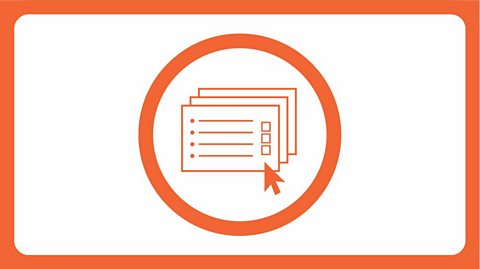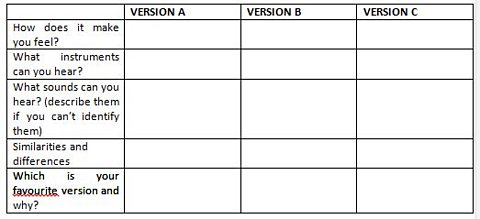For:
- Key Stage 3 in England and Wales
- Third/Fourth Level, S1-S3 in Scotland
- Key Stage 3 in Northern Ireland
You can also download the lesson plans as a PDF with accompanying powerpoint slides.
Written by Rachel Leach
Background
The composer: Delia DERBYSHIRE (1937ÔÇô2001)
- British composer of electronic music
- Member of the legendary │╔╚╦┐ý╩Í Radiophonic Workshop ÔÇô a group of pioneering musicians and engineers responsible for producing sound effects and incidental sounds for tv and radio
Explore and download lesson plans for six weeks of learning and activities for Doctor Who Theme by Delia Derbyshire.

The music: Doctor Who Theme
- The famous melody was actually written by Australian composer Roy Grainer. DeliaÔÇÖs task was to ÔÇÿrealiseÔÇÖ or ÔÇÿarrangeÔÇÖ the theme using electronic sounds to match the futuristic sci-fi nature of the programme
- DerbyshireÔÇÖs version uses ÔÇÿfound soundsÔÇÖ that were manipulated electronically. She recorded the sound of everyday objects onto tape and then changed the speed of the tape to create different pitches or looped single sounds over and over to create rhythms. This was back in 1963 before computers made such experiments easy!
- Scandalously, Derbyshire was not credited with the composition of the now iconic original version and received very little money for it
Trailblazer: Composer Delia Derbyshire created a new sound-world using electronic sounds, using these to arrange the melody for Doctor Who ÔÇô one of the most famous TV shows ever!
Explore and download powerpoint slides for six weeks of learning and activities for the Doctor Who Theme by Delia Derbyshire.

Learning outcomes
Learners will:
- Listen and reflect on a piece of orchestral music
- Create their own piece of music using instruments, voice and technology
- Learn musical language appropriate to the task
Curriculum checklist:
- listen with increasing discrimination to a wide range of music from great composers and musicians
- play and perform confidently in a range of solo and ensemble contexts using voice, playing instruments fluently and with accuracy and expression
- improvise and compose; and extend and develop musical ideas by drawing on a range of musical structures, genres and traditions
Glossary of music terms used:
- Found sound - sounds found in the ÔÇÿnaturalÔÇÖ world or made from non-musical objects and then used to make music
- Melody - another word for ÔÇÿtuneÔÇÖ. A musical sentence
- Orchestrate - choose which instruments perform which parts of the music
- Ostinato - a repeating (often rhythmic) pattern
- Sample - a small snippet of an existing sound recording
Glossary terms can be found in bold throughout.
Resources required:
- musical instruments
- music editing software ÔÇô the lesson plans below use Audacity. This is free to download and compatible with most desktop computers. Feel free to adapt to use with whatever software you are familiar.
This scheme of work is plotted out over six lessons. Feel free to adapt it to suit your children and the resources you have available.
The six lessons at a glance
Lesson 1:
Activities:
- Watch the film
- Listen to the performance
- Analyse the music
- Compare and contrast several versions
Curriculum link:
- Listen with increasing discrimination to a wide range of music from great composers and musicians
- Identify and use the interrelated dimensions of music expressively and with increasing sophistication, including use of tonalities, different types of scales and other musical devices
- Develop a deepening understanding of the music that they perform and to which they listen, and its history
Lesson 2:
Activities: Play the Doctor Who theme on ÔÇÿfound soundsÔÇÖ
Curriculum link:
- Listen with increasing discrimination to a wide range of music from great composers and musicians
- Play and perform confidently in a range of solo and ensemble contexts using voice, playing instruments fluently and with accuracy and expression
Lesson 3:
Activities:
- Record sounds from around the school
Curriculum link:
- Listen with increasing discrimination to a wide range of music from great composers and musicians
Lesson 4:
Activities:
- Manipulate sound files using music editing software
- Create samples
Curriculum link:
- Listen with increasing discrimination to a wide range of music from great composers and musicians
- Improvise and compose; and extend and develop musical ideas by drawing on a range of musical structures, genres and traditions
Lesson 5:
Activities:
- Create rhythms and melodies from found sounds using music editing software
- Use musical terminology appropriate to the task
- Structure sections of music into a bigger piece
Curriculum link:
- Listen with increasing discrimination to a wide range of music from great composers and musicians
- Improvise and compose; and extend and develop musical ideas by drawing on a range of musical structures, genres and traditions
Lesson 6:
Activities:
- ÔÇÿRealiseÔÇÖ or ÔÇÿarrangeÔÇÖ Ron GrainerÔÇÖs theme using a range of sounds ÔÇô live and recorded
Curriculum link:
- Listen with increasing discrimination to a wide range of music from great composers and musicians
- Improvise and compose; and extend and develop musical ideas by drawing on a range of musical structures, genres and traditions

LESSON 1 - Watching and listening
- Prepare your class
Explain to your class that you are going to begin a six-week music project focusing on a fantastic piece of music by a composer called Delia Derbyshire and watch the full orchestral performance of the Doctor Who Theme.
Ask them if they recognise it!
- Watch the │╔╚╦┐ý╩Í Ten Pieces Trailblazers film and have a discussion about Delia Derbyshire. Ask your class to think about :
- Why there were so few women composers in the past
- What working at the Radiophonic Workshop and inventing sound effects might have been like
- How Delia must have felt after receiving no public recognition for her work
Segun Akinola introduces the Doctor Who theme. Segun became the composer for the show in 2018. We learn how he was inspired by the original work of Delia Derbyshire & Ron Grainer.
- Listening task
Listen or watch the full orchestra performance again and point out that it is constructed from two musical ideas, can your students identify them?
There is a pounding bassline and a swooping melody.
Listen to the opening credits of the Doctor Who Theme arranged by Delia Derbyshire.
- Ask your students to draw this table (or simply print it out for them):

- Listen to three different versions of the theme as follows:
a. │╔╚╦┐ý╩Í Ten Pieces version (Segun Akinola 2018)
b. Orchestral version (Murray Gold 2005)
c. Original version (Delia Derbyshire 1963)
 and ask your students to fill in this table as they listen. If possible disguise the order of these and dont tell your class which is which so they are not influenced by the year, etc. (All the many different versions are available on YouTube.)
- FINALLY, - discuss the answers and fill in a class version of the table on the board.
Some answers:
The more recent versions use a combination of orchestral instruments and synthesizers. Derbyshire used ÔÇÿfound soundsÔÇÖ instead of instruments. All of her sounds were everyday items recorded onto tape and then the tape was manipulated to make different pitches and rhythms. Her ÔÇÿinstrumentsÔÇÖ include a plucked piano string and an electronic signal tone.

LESSON 2 - RonÔÇÖs theme ÔÇô live!
Remind your class that Ron Grainer wrote the melody and then asked Delia to ÔÇÿrealiseÔÇÖ or ÔÇÿarrangeÔÇÖ it electronically. Your studentsÔÇÖ first task is to perform his melody using whatever resources they have available. This could be conventional instruments, body percussion, voice or ÔÇÿfound soundsÔÇÖ (i.e. everyday objects turned into instruments).
The theme has two ingredients:
a. The bassline has two contrasting pitches:

Instead of the pitches above, challenge your students to find objects that make two contrasting, similar sounds ÔÇô perhaps they could tap a pencil on the seat of a chair and then the legs of the chair for example.
b. The melody

Begin by singing it with a swooping ÔÇÿoooÔÇÖ sound then ask your class to invent other ways of performing it again, using a mix of conventional and unconventional sounds. This is a much harder task! They might have to find different sounds for each pitch and create the rough shape of the tune rather than try to match it exactly
You might like to split the class into small groups at this point and challenge them to find sounds for both elements to make their own versions of the tune.
- FINALLY, create a class version of the theme by putting the bassline and the melody together. If you are working in small groups, bring the class back together at this point. Since 1963 there have been many, many versions of the theme ÔÇô at least one for each new ÔÇÿdoctorÔÇÖ ÔÇô so you could keep your group pieces separate if they are very different from one another.

LESSON 3 - ÔÇÿFound soundsÔÇÖ
Delia Derbyshire used onlyÔÇÿfound soundsÔÇÖfor her version of the theme ÔÇô she chose objects rather than traditional instruments and instead of playing them live she recorded them and manipulated the recordings.
If you havenÔÇÖt yet listened to DeliaÔÇÖs original version of theme, do so now. It is wildly available online. Afterwards explain that the melody was made from one electronic note and the rhythm from one plucked piano string.
Split your class into pairs and ask each pair to find and record some interesting sounds ÔÇô just the sounds of everyday objects they find around the school. Challenge each pair to record as many sounds as they like and name them.
Your students can do this using whatever recording equipment you have available. It can be done on a smart phone or tablet very easily.
Bring the class back together. Hear and discuss the sounds you have found and write their names down on the board. Check that each pair has different sounds from each other and that they are as contrasting as possible.
**FINALLY, show your students how to upload these sounds into the software they are going to use for the rest of this project. If using Audacity, follow these simple steps:
- Upload the sounds to the desktop of the computer making sure they are carefully named
- Open Audacity and show your children how to upload their sounds:
- Click: file
- Click: Import  Audio
- Choose the file from the desktop
Each sound should appear as a different track.

LESSON 4 - Manipulation, special effects and sampling
For this lesson you need music editing software such as Audacity (available as a free download). If you donÔÇÖt have access to Audacity please adapt this plan to suit the software and resources you do have. Ideally the students should continue to work in pairs (or small groups) but if you only have one computer or whiteboard, simply lead the tasks for the full class and ask for volunteers to help.
Ensure that each pair or group has a computer with their sounds loaded onto it and their Audacity file open.
Demonstrate how to edit the sounds and therefore take out any unnecessary silence at the beginning or end:
- Click and drag over the bit you DONÔÇÖT want ÔÇô this will be highlighted
- Click: Scissors icon at the top
If at any time a mistake is made, UNDO is ÔÇô
- Click: edit
- Click: undo
- To listen to one sound at a time, rather than all the tracks at once:
- Click: solo (on the right-hand box at the start of the sound file, underneath its name)
- When all of the sounds are edited and your students are beginning to understand the software ask them to start manipulating their sounds.
Show them these simple steps:
a. Click: solo on the sound they want to manipulate (the other sounds will go grey)
b. Highlight the sound file by clicking and dragging over it (it will go white)
c. Click: effect
d. Choose an effect from the list.
e. Move the sliders or change the numbers in boxes
f. Click: apply
g. Listen by clicking the play icon
Some of the effects work better than others. For each change the shape of the soundwave changes too. DonÔÇÖt worry if this feels a bit experimental ÔÇô Delia often didnÔÇÖt know what sounds she would end up with when she experimented!
- Demonstrate how to make a sample of existing music.
There are two ways to do this:
- Upload an existing music track into Audacity (you could even use DeliaÔÇÖs original version of the theme for this). Highlight a very small snippet of it. Delete the rest. Manipulate this new sound using the method above
- Or, record a small snippet of a music track into your recording device, upload this into Audacity and manipulate as above
Challenge each team to manipulate their sounds and samples until they have a bank of new contrasting sounds.
FINALLY, as a full class listen back to some of these new sounds and see if the listeners can guess which object or track they started out as. Make sure all of these files are safely saved for next time.

LESSON 5 - Looping, pitching and composing
Begin in groups again with the Audacity files open from last time.
Demonstrate how to ÔÇÿloopÔÇÖ a sound to create a rhythm (i.e. repeat it over and over):
- Select the sound to manipulate but clicking solo and highlighting
- Click: effect
- Click: ░¨▒▒Þ▒▓╣│┘ÔǪ
- Enter a number in the box
- Click: ok
Listen to your loop by clicking on the play icon.
Your sound will now repeat around. You have made an ostinato from a found sound just like DeliaÔÇÖs bassline.
- Demonstrate how to make a ÔÇÿmelodyÔÇÖ:
- Select the sound to manipulate but clicking solo and highlighting (it helps if this one is short and already has a pitch)
- Click: effect
- Click: change pitch
- Move the slider
- Click: apply
If you copy this sound (highlight, click edit: copy, click somewhere else, click edit: paste), and repeat these steps you can make a chain of ÔÇÿnotesÔÇÖ ÔÇô i.e. a melody.
- Demonstrate how to add in some classic electronic sounds similar to those Delia worked with:
- Click where you want the sound to go (anywhere on one of the tracks)
- Click: Generate
- Click: Chirp
- Click: ok
A very 1960s sounding ÔÇÿchirpÔÇÖ is added to your music where you clicked. This can also be manipulated. There are other sounds under the ÔÇÿgenerateÔÇÖ menu that are fun additions.
- Challenge your class to structure their ideas into a finished piece. To do this they must move their ideas around thinking carefully about the order of events and how to layer up their ideas. The easiest way to do this is as follows:
- Highlight section you want to move
- Click: copy
- Click where you want it to go
- Click: paste
Or upload your new manipulated sound files into software such as Garage Band or BandLab ÔÇô these are much easier interfaces for composing.
- FINALLY, challenge your students to have completed their new piece by the end of this lesson. Encourage your ÔÇÿcomposersÔÇÖ to think what their music might be describing and invent an appropriate title for their work. It might be fun for them to think about what type of TV show or film their music would accompany ÔÇô they can invent this show and its content.

LESSON 6 - Structure and finish
Listen back to the finished pieces from last lesson and encourage the rest of the class to give gentle feedback.
Challenge your ÔÇÿcomposersÔÇÖ to use their new sound editing skills to ÔÇÿrealiseÔÇÖ or ÔÇÿarrangeÔÇÖ the Doctor Who theme just as Delia Derbyshire did. For this they can use a mixture of:
- 'found sounds'
- real musical instruments either played live, recorded, or even recorded and manipulated
- body percussion
- vocal sounds
- samples (including samples from the original theme)
Their finished ÔÇÿrealisationÔÇÖ must feature the iconic pounding bassline and swooping melody but they may add in as many other ingredients as they like.
- FINALLY, end this project with a performance of all your Doctor Who themes alongside all of the new music created.

TAKING IT FURTHER - Cross-curricular activities
SOUND EFFECTS: The │╔╚╦┐ý╩Í Radiophonic workshop existed to make sound effects for tv and Radio. Try making sound effects to accompany a play, film or podcast.
LITERACY: write the first episode of your invented tv show. Do this as a play script, stage it and add sound effects.
RESEARCH: discover more about the │╔╚╦┐ý╩Í Radiophonic Workshop and its pioneers.
UPLOAD: Show us what youÔÇÖve created! Submit your creative responses using our Uploader for a chance to be featured on the Ten Pieces website.
Upload and showcase your creative responses
Upload your creative responses to the Ten Pieces repertoire for your chance to feature in the Ten Pieces creative showcase.
